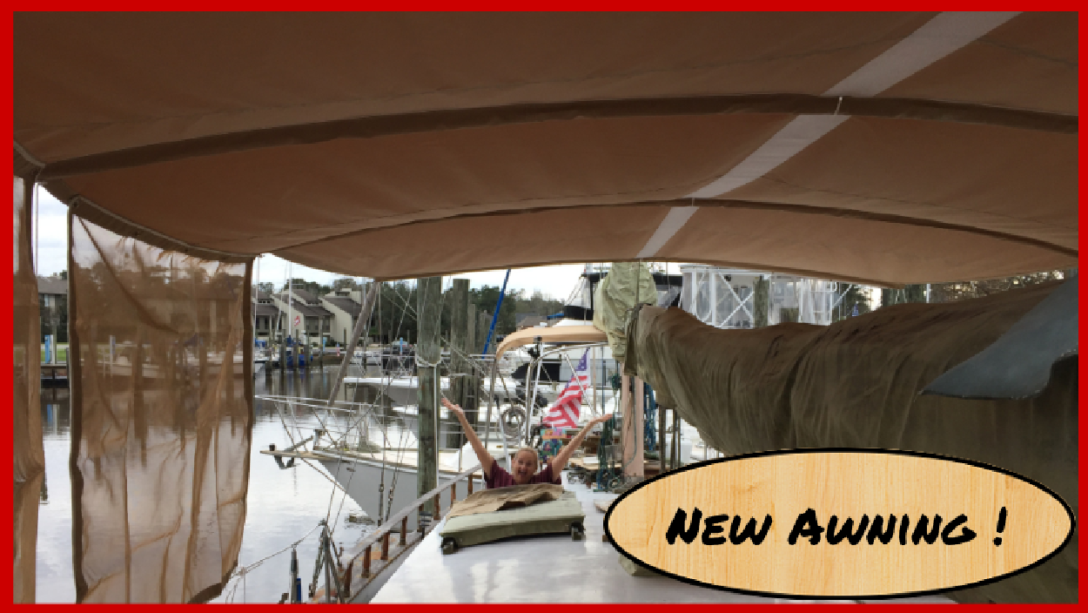We have long realized that we wanted to put on some kind awning or cover. Mainly we wanted something that when at the dock or anchor we could put it up to shade the top of the boat. This simple thing can help the air conditioners run much more efficiently and reduce the overall strain on the units. When at anchor shading the top of the boat from direct sunlight can provide a 10 degree (Fahrenheit) difference in temperature down below.
My plan had been to make my cover. I designed and tested something that I believe would work well. It is similar to an old “chuck wagon” from the days of the old west, and not too unlike a design that the company ShadeTree uses on theirs.
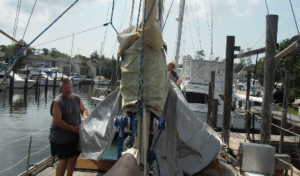
This was a template for our original design.
The difference was in my frame and mounting system. I tested it out with everything except sewing the material. I bought all the supplies including the Sailrite® sewing machine, Sunbrella®, UV thread, and made all of the flexible removable and foldable half dome supports. The problem was that something this large was not a good place to start to learn how to sew well with the Sailrite. I made a compass cover before this, and the first large connection was to sew two panels together that were 21 feet long. I sewed the wrong sides together, and after spending 4 hours removing all of that stitching, I put everything away and continued to procrastinate.
Deb had enough of my procrastination and rightfully so. It is getting ready to be spring time and has been raining buckets here the last month and likely will the next month or two. It is also the time of year when the temperature has some good days and not having the cover up was starting to impact progress on boat projects. She broke down and had someone come out to get a quote for the job.
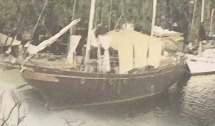
Mural in a local hotel with our boat in the picture from many years ago
The good news is she found the same company that made the awning that was on our boat many years ago with the previous owner. We found parts of it in storage lockers (the side curtains) and ironically enough there is a local hotel that has an old photo of our boat on a mural on their wall. In that picture, you can see the general shape of the shade. Deb took a chance and called the sail loft that made one of our sails, and sure enough, the guy remembered making the cover about 12 years ago. He came out to see what he could re-use from the old one and explain to us the best way to do the new one. The good news is, he had some lessons learned, for example on the new one he recommended that we don’t go back up with PVC supports, but rather, square tube aluminum as it would be lighter, stronger and not as thick to store.
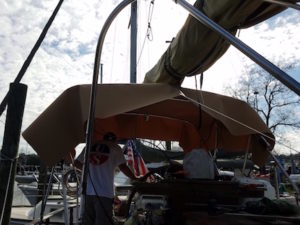
Dry Fitting the rear bimini and getting zipper locations identified
We are having a new bimini cover made for the rear most bimini, they are re-stitching and putting new zippers over the bimini that covers the helm. They made this new awning that goes between the main and mizzen masts. We are having another stand alone unit made that will go from the main mast forward to the bow. They will also be making panels that will connect the main unit and the one forward of the mast together as well as some panels to extend aft past the mizzen to cover the companionway as well. This is quite a large cover for sure.
The company doing the work has been excellent. They have been to the boat a few times to measure, validate and collaborate on the overall design and functionality. The partnership has been great because I am not left with a wait and see what we get kind of a solution. We talked in detail about this, and they made suggestions for small comprises from my original thoughts that would provide more rigidity and strength. So far their suggestions have all been very sound and made perfect sense.
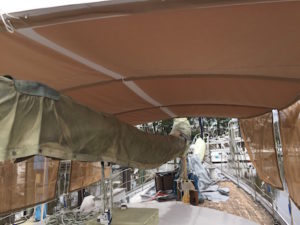 Installation was not too difficult, but Deb and I will take it all down and put it up a few times on our own to see just how easy it is for the 2 of us. The reality with any cover like this is that you want to be able to take it down quickly in the event there is an unexpected front coming through. The designer and builder are estimating that this is likely good even in 40 knots of wind, but obviously, we don’t want to just guess at that so will be checking it out with any strong gusts we get. If something were to come loose, we need to re-consider its lashing methods.
Installation was not too difficult, but Deb and I will take it all down and put it up a few times on our own to see just how easy it is for the 2 of us. The reality with any cover like this is that you want to be able to take it down quickly in the event there is an unexpected front coming through. The designer and builder are estimating that this is likely good even in 40 knots of wind, but obviously, we don’t want to just guess at that so will be checking it out with any strong gusts we get. If something were to come loose, we need to re-consider its lashing methods.
In the end, we will likely change the attachment method and go with premade lengths of cord and hooks. We want to be able to toss the whole bundle onto the boom, connect the two rear lashings to the stanchion roll it forward attaching it at each stanchion along the way and then just raise it on the halyard until everything it tensioned the way we believe it should be. These hooks and fixed length straps will reduce having to untie and tie each connection point.
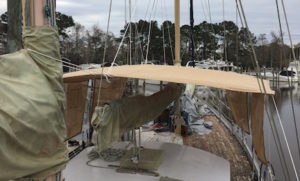 The fabricator asked us not to do that until they complete all the pieces so that if adjustments are needed, they can still do so.
The fabricator asked us not to do that until they complete all the pieces so that if adjustments are needed, they can still do so.
This project has been great so far. Just after the first day, the deck didn’t have that morning dew on it which will be very helpful as we make some repairs on deck as we remove the teak. I am comfortable painting the surface and putting down fiberglass resin and mat on the deck as well knowing that this will keep that morning dew or moisture down as well.
I continue to look out the forward coach house ports to the covered deck, and it is shocking just how much additional usable space that frees up. With the side curtains, even the little one can play around without me being quite the nervous wreck every few seconds because the mesh material goes right down over the top lifeline.
This awning installation has been a great re-motivator for Deb and I. It is funny how getting something in place that starts to make the boat look better and function better has made us want to pick up the pace on the refit work. So much so that this week while I was out of town, Deb already started to pull some of the panels down in McKinlee’s stateroom to re-insulate between the hull and the room. This winter, as it has been pretty cold here, we noticed the condensation problems. Insulating this will go a long way to reducing that condensation, BUT that is likely a future post on the blog as I suspect we will be doing that work soon.
We put together a video of the installation. I hope you enjoy it, share it and do me a favor and let me know if you think others would benefit from it as well.
If so, please email me at glhotka@svdreamchaser.com and let me know your thoughts.
Feel free to repost this article with embedded video to your favorite sailing group, sailing club or even point them to our youtube channel or Facebook channel for more info as well.

